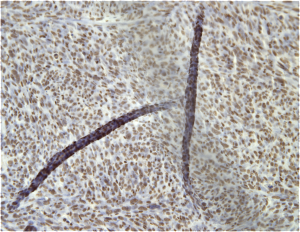Landreville S, Vigneault F, Bergeron MA, Leclerc S, Gaudreault M, Morcos M, Mouriaux F, Salesse C, Guérin SL. Suppression of α5 gene expression is closely related to the tumorigenic properties of uveal melanoma cell lines. Pigment Cell Melanoma Res. 2011 Aug;24(4):643-55.
Scientific impact: Uveal melanoma is an ocular cancer that threatens patient’s survival once it generates metastases. Many studies focused on the mechanisms leading to metastasis, but many contradictions are present throughout the literature about the roles that integrins play in that process. By comparing different uveal melanoma cell lines, this study demonstrated the critical function exerted by the α5 integrin subunit that, when absent, contributes to the metastatic spreading of this type of cancer. The regulatory proteins that modulate expression of the α5 gene may therefore represent potential targets for early detection or treatment of metastatic uveal melanoma.
Network contribution: This work is a collaboration between many members of the VHRN and was partly supported by network grants (ocular tissue bank and master’s research training award of MA Bergeron).
* * *
Original Abstract
Cancer aggressiveness is related to the ability of cancer cells to escape the anchorage dependency toward the extracellular matrix, a process regulated by the integrin α5β1 and its ligand fibronectin. Here, we characterized the expression of the α5 gene in human uveal melanoma cell lines with distinct tumorigenic properties and investigated some of the mechanisms underlying the variations of their malignancy. Strong and weak expression of α5 was observed in cells with no (T108/T115) and high (T97/T98) tumorigenic properties, respectively. Expression and DNA binding of the transcription factors Sp1, activator protein 1 (AP-1) (both acting as activators), and nuclear factor I (NFI) (a strong repressor) to the α5 promoter were demonstrated in all cell lines. A reduced expression of AP-1 combined with a dramatic increase in NFI correlated with the suppression of α5 expression in T97 and T98 cells. Restoring α5 expression in T97 cells entirely abolished their tumorigenicity in immunodeficient mice. These uveal melanoma cell lines might therefore prove particularly useful as cellular models to investigate α5β1 function in the pathogenesis of invasive uveal melanoma.
Sections of a subcutaneous tumor produced by the uveal melanoma cell line T97 that vasculogenic mimicry patterns (dark). The immunohistochemical analysis was performed using a diaminobenzidine (DAB) biotin-streptavidine complex with a rabbit antibody raised against the S100 protein (brown nuclei) as the primary antibody



